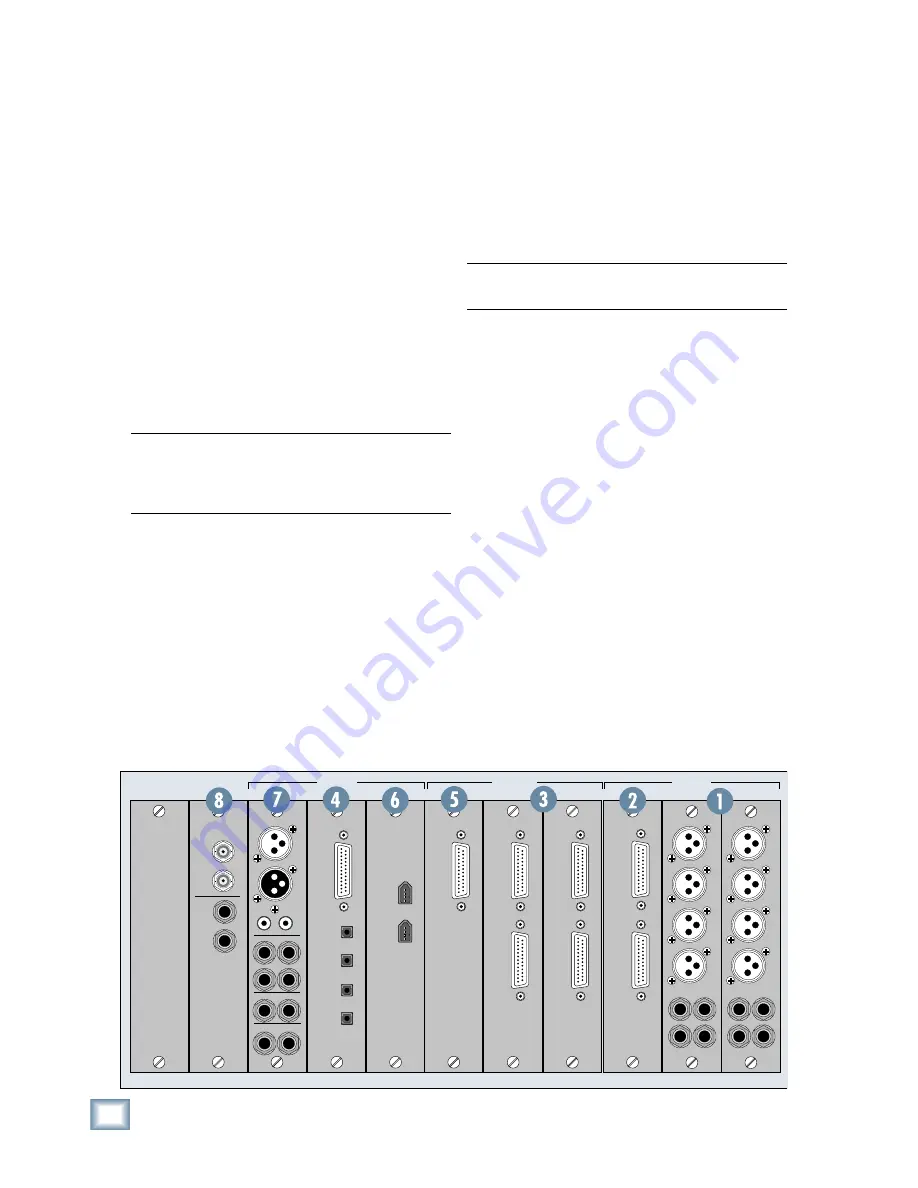
10
X.200
Digital X Bus
3. LINE CARD
The Line card has two female DB25 connectors.
One provides eight balanced line-level inputs, and
the other provides eight balanced line-level outputs.
They use the TASCAM standard pinout for analog
signal connections (the same standard used on the
analog cards for the Mackie D8B and Hard Disk
Recorder). If you are connecting these to another
device using the same DB25 standard, you can use
a DB25-to-DB25 audio cable. Otherwise, you will
need to use DB25 cables that breakout to XLR, 1/4"
TRS, or TT connectors.
Refer to Appendix B for a wiring diagram of these
connectors.
The Line card also has the –10 dBv/+4 dBu jump-
ers (described for the Mic/Line 4 card) that can be
left in place (for +4 dBu operation) or removed (for
–10 dBv operation).
Note:
The Mic/Line 4 card, Mic/Line 8 card, and
Line card all support analog-to-digital conversion at
sampling rates up to 192 kHz and word lengths of
either 16 or 24 bits.
4. DIGITAL CARD
This card provides up to eight channels of digital
audio in two formats; TDIF-1 on a DB25 connector
and ADAT optical on four TOSLINK connectors.
The input type is selected in software (either
TDIF or ADAT). However, just because we can, we
made both sets of outputs alsways active for you
to use. This makes the Digital card a great format
converter between TDIF-1 and ADAT optical digital
devices.
At 44.1/48 kHz sample rates, each optical
TOSLINK connector provides either eight inputs
or eight outputs of digital audio. At 88.2/96 kHz
sample rates, the S/MUX protocol is used to provide
four channels of I/O on the “A” connectors, and four
channels of I/O on the “B” connectors. At 176.4/192
kHz sample rates, the S/MUX II protocol is used to
provide two channels of I/O on the “A” connectors
and two channels of I/O on the “B” connectors, for a
total of four inputs and outputs.
Note:
The TDIF connector does not operate above
96 kHz.
5. AES/EBU CARD
The AES/EBU card has one DB25 connector,
providing eight channels of digital I/O in the
AES/EBU format.
The original AES/EBU specifi cation (IEC958 Type 1)
provides for carrying two channels of digital audio
at resolutions up to 24-bit at 48 kHz. When higher
sampling rates became possible, two methods were
developed to transmit digital audio at the higher
sample rates — double-fast and double-wide.
The double-fast method (also called single-wire)
clocks the digital I/O port at twice the speed to get
twice the information through, providing support for
resolutions up to 24-bit at 96 kHz.
The double-wide method (also called dual-wire)
transmits one channel of digital audio instead of two
channels through a single digital I/O port, again pro-
viding support for resolutions up to 24-bit at 96 kHz.
The AES/EBU card currently uses the double-fast
method, so eight channels of digital I/O are sup-
ported up to 192 kHz.
WORD
CLOCK
SYNC CARD
IN
OUT
IN
OUT
SMPTE
A
B
MIX OUT CARD
SPDIF
SPEAKERS
PHONES
MIX OUT
IN
OUT
IN
L
R
1
2
L
R
L
R
OUT
AES/EBU
FIRE CARD
DIGITAL CARD
OPTICAL
TDIF
I/O
IN A
IN B
OUT A
OUT B
MIC/LINE 4 CARD
5
7
6
8
1
2
3
4
MIC/LINE 4 CARD
5
7
6
8
1
2
3
4
MIC/LINE 8 CARD
IN
OUT
I/O
AES CARD
OUT
IN
LINE CARD
OUT
LINE CARD
IN
SYNC
C • SLOTS
D • SLOT
B • SLOTS
A • SLOTS
Содержание X.200
Страница 1: ...OWNER S MANUAL X 200 Manual Rev 1 0 4 March 7 2005...
Страница 61: ...61 Owner s Manual Owner s Manual...
Страница 82: ...82 X 200 Digital X Bus...
Страница 93: ...93 Owner s Manual Owner s Manual...
Страница 94: ...94 X 200 Digital X Bus Index...
Страница 95: ...95 Owner s Manual Owner s Manual...











































